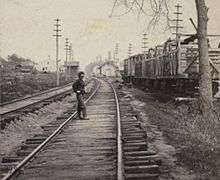Williams Bridge station
The Williams Bridge station (also known as Williams Bridge–East 210th Street station) is a commuter rail stop on the Metro-North Railroad's Harlem Line, serving the Williamsbridge and Norwood sections of the Bronx, New York City. It is 10.5 miles (16.9 km) from Grand Central Terminal and travel time there is approximately 24 minutes. The station is located at the intersection of Gun Hill Road and Webster Avenue. Due to its short platform length, only the doors of four cars can open for passengers.
Williams Bridge | ||||||||||||||||
|---|---|---|---|---|---|---|---|---|---|---|---|---|---|---|---|---|
Southbound view of the Gun Hill Road Bridge over Williams Bridge station | ||||||||||||||||
| Location | 402 Gun Hill Road, Norwood, Bronx, New York | |||||||||||||||
| Coordinates | 40.8788°N 73.8707°W | |||||||||||||||
| Owned by | Metro-North Railroad | |||||||||||||||
| Line(s) | Harlem Line | |||||||||||||||
| Platforms | 2 side platforms | |||||||||||||||
| Tracks | 4 | |||||||||||||||
| Connections | New York City Subway: New York City Bus: Bx28, Bx30, Bx38, Bx41 | |||||||||||||||
| Other information | ||||||||||||||||
| Fare zone | 2 | |||||||||||||||
| History | ||||||||||||||||
| Opened | September 3, 1842[1] | |||||||||||||||
| Electrified | 700V (DC) third rail | |||||||||||||||
| Traffic | ||||||||||||||||
| Passengers (2007) | 53,248 | |||||||||||||||
| Services | ||||||||||||||||
| ||||||||||||||||
| Former services | ||||||||||||||||
| ||||||||||||||||
This station is located in the Zone 2 Metro-North fare zone.
History

Rail service in Williams Bridge can be traced as far back as 1842 with the establishment of the New York and Harlem Railroad, which became part of the New York Central and Hudson River Railroad in 1864 and eventually taken over by the New York Central Railroad. Williams Bridge Station itself, which was originally built sometime in the 19th century, originally had a station house on the southeast corner of the Gun Hill Road bridge and even had a turntable.
From 1920 through 1973, the 210th Street–Williamsbridge station of the elevated IRT Third Avenue Line was close to the Williams Bridge station.[2] The Third Avenue Line used to curve from Webster Avenue over Gun Hill Road, then crossed over the Harlem Line tracks on a two-level bridge carrying Gun Hill Road and the Third Avenue El.[3] The line terminated at Gun Hill Road station on the IRT White Plains Road Line, along White Plains Road to the east.
As with many NYCRR stations in the Bronx, the station became a Penn Central station once the NYC & Pennsylvania Railroads merged in 1968. Penn Central's continuous financial despair throughout the 1970s forced them to turn over their commuter service to the Metropolitan Transportation Authority. The station and the railroad were turned over to Conrail in 1976, and eventually became part of the MTA's Metro-North Railroad in 1983. Access to a parking lot on the site of the former station house was available from the southbound on-ramp of the Bronx River Parkway, which had two way traffic from Gun Hill Road to the parking lot until the 1990s, and was named Newell Street between those two points.
Station layout
This station has two offset high-level side platforms, each four cars long[4]:10 and accessible from East Gun Hill Road (East 210th Street). When trains stop at this station, normally the front four open cars receive and discharge passengers.
| G | Street level | Exit/entrance and buses |
| P Platform level |
Side platform, doors will open on the right | |
| Track 4 | ← Harlem Line toward Grand Central (Fordham) ← New Haven Line does not stop here | |
| Track 2 | ← Harlem Line and New Haven Line express service does not stop here | |
| Track 1 | Harlem Line and New Haven Line express service does not stop here → | |
| Track 3 | New Haven Line does not stop here → Harlem Line toward North White Plains (Woodlawn) → | |
| Side platform, doors will open on the right | ||
Bibliography
- Dunbar, Seymour (1915). A History of Travel in America: Being an Outline of the Development in Modes of Travel from Archaic Vehicles of Colonial Times to the Completion of the First Transcontinental Railroad: the Influence of the Indians on the Free Movement and Territorial Unity of the White Race: the Part Played by Travel Methods in the Economic Conquest of the Continent: and Those Related Human Experiences, Changing Social Conditions and Governmental Attitudes which Accompanied the Growth of a National Travel System · Volume 3. Indianapolis, Indiana: Bobbs-Merrill Company. Retrieved May 24, 2020.
References
- Dunbar 1915, p. 984.
- 3rd Ave El just south of the northbound platform of the 210th St Station, looking south at the NYC Harlem Branch by Vic Gordon (NYCSubway.org)
- April 1973 View of 3rd Ave. el from upper level by Kenneth Palter (NYCSubway.org)
- "Metro-North Railroad Track & Structures Department Track Charts Maintenance Program Interlocking Diagrams & Yard Diagrams 2015" (PDF). Metro-North Railroad. 2015. Retrieved January 28, 2019.